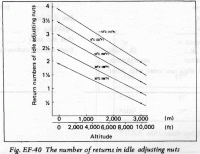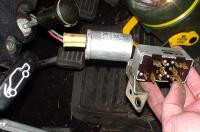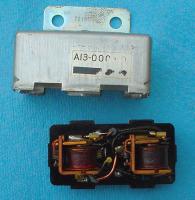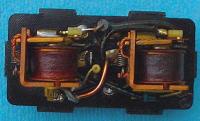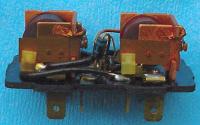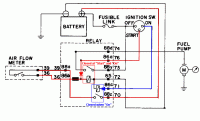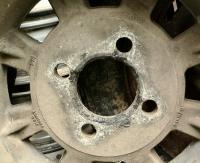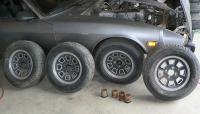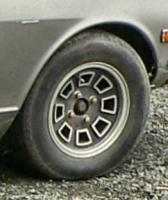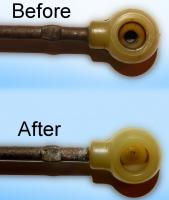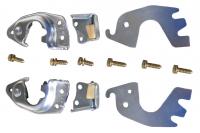Everything posted by 240260280z
-
Modern material for making new interior firewall insulator?
Just a photo update. Flew the template copied from the saggy ripped-up original 1000km and installed. Many holes were way off the mark or not suitable in shape or size. Re cut and drew centres to fit....now to make "Mark I"
-
17mm lock nut on valves
http://www.picturetrail.com/sfx/album/view/1803105
-
rpm 650, balance screw set! unisys flow even, ....mixture knob/disks need many turns?
Absolutely sound advice with numbers behind it! FYI Here is what the 72 FSM gives for temp and altitude compensation:
-
Fuel pump and Relay problem
follow the wiring from battery to pump and measure 12v as you go at all connectors. Don't worry about other efi components at this time: "work the problem". Just turn key to on and connect afm switch (move flap up) to ensure power to pump path is in a running mode before you start your hunt. Here is a wiring diagram:http://www.atlanticz.ca/zclub/techtips/wiringdiagrams/76_280z_wiring.pdf
-
Fuel pump and Relay problem
-
Fuel pump and Relay problem
- Weber 40 DCOE Rebuild Kit Part Identification?
Anyone?- The official "Post pictures of your wheels" thread
It was on an old 260z 2+2 that I helped a guy revive in 2006. I forget what brand... maybe British: Ahhh I found these pics. Yup they are British "Mag Product" looks like 6 X 14" Web Research: MAG: Mill Accessory Group Found some similar on French Car Forums with 914's.- Wobbling dizzy
There is not much to a distributor: In the picture below, Part #12 (Shaft) turns inside part #13 (Housing). The housing has a bushing that keeps the shaft in place. Your problem is either a bent shaft or a worn bushing. Shaft Housing showing bushing- Fuel pump and Relay problem
Did you check the switch inside the AFM that sends current to the pump?- That Cap Fits Me Right Fine
From the wiki link: Fast and slow charge and discharge The capacity of a lead-acid battery is not a fixed quantity but varies according to how quickly it is discharged. An empirical relationship exists between discharge rate and capacity, known as Peukert's law. When a battery is charged or discharged, this initially affects only the reacting chemicals, which are at the interface between the electrodes and the electrolyte. With time, the charge stored in the chemicals at the interface, often called "interface charge", spreads by diffusion of these chemicals throughout the volume of the active material. If a battery has been completely discharged (e.g. the car lights were left on overnight) and next is given a fast charge for only a few minutes, then during the short charging time it develops only a charge near the interface. The battery voltage may rise to be close to the charger voltage so that the charging current decreases significantly. After a few hours this interface charge will spread to the volume of the electrode and electrolyte, leading to an interface charge so low that it may be insufficient to start the car. On the other hand, if the battery is given a slow charge, which takes longer, then the battery will become more fully charged. During a slow charge the interface charge has time to redistribute to the volume of the electrodes and electrolyte, while being replenished by the charger. The battery voltage remains below the charger voltage throughout this process allowing charge to flow into the battery. Similarly, if a battery is subject to a fast discharge (such as starting a car, a current draw of more than 100 amps) for a few minutes, it will appear to go dead, exhibiting reduced voltage and power. However, it may have only lost its interface charge. If the discharge is halted for a few minutes the battery may resume normal operation at the appropriate voltage and power for its state of discharge. On the other hand, if a battery is subject to a slow, deep discharge (such as leaving the car lights on, a current draw of less than 7 amps) for hours, then any observed reduction in battery performance is likely permanent.- That Cap Fits Me Right Fine
As a rule of thumb; lead-acid batteries should not be drained beyond 1/2 charge if one wants them to last for a long time. Car batteries are designed (plates sizes, spacing, and geometry) for short burst of high current output not long periods of low current output. Which what leaving one's lights on does. In charging a battery, there are also electrochemical related inefficiencies and heat losses, Good read: http://en.wikipedia.org/wiki/Lead–acid_battery- Need hatch inner seal
read this stuff: http://www.classiczcars.com/forums/showthread.php?37308-Kia-Sportage-weatherstip-rocks!&highlight=hatch+seal http://www.classiczcars.com/forums/showthread.php?42860-Installing-weather-strip-sucks!-Especially-the-hatch&highlight=hatch+seal http://www.classiczcars.com/forums/showthread.php?37850-hatch-window-seal-MSA-vs.-VB-pics&highlight=hatch+seal- The official "Post pictures of your wheels" thread
- rpm 650, balance screw set! unisys flow even, ....mixture knob/disks need many turns?
It is someone's mini with SU's. Looks like somewhere in Europe.- SU Mixture Question
Internet arguments (the friendly Ancient Greek way like this) are not productive when we are both partially correct and both partially incorrect... I concede and we owe each other beers It has motivated me however: I just pulled out my USB AtoD developer kit, some Motorola air pressure sensors , some VB books and loaded VB5 on my laptop.... my flow bench project that was stopped many years ago when my friends/co-workers back stabbed me and I momentarily lost my job and career is now back in business I hope to have a calibrated system running soon for measuring this stuff.- SU Mixture Question
I do not agree. The piston is an air restriction up stream of the throttle valve. In fact, there is a rubber bumper on the piston to prevent it from completely closing and blocking all air. As well, my O2 sensor goes very lean when I lift one piston so I am adding more air and reducing fuel at the same time. The air from the three non-firing cylinders dilutes the exhaust gas.- Interesting Discovery Furniture Stripper Cleans Yellow Nylon
On throttle linkage... sort of yellow nylon to begin with so not a big change like the strikers. Changed the metal a little too. Red flecks were from my paint brush and the work done earlier today.- SU Mixture Question
For a stock system, the mixture knob should be set for idle a/f only and the needle's taper should be adjusted for a/f ratio at different rpms/load. (adjusting the needle means swapping it, sanding it, or turning a new one on a lathe). In a stock system, the needle taper should already be optimized for a balance of power, emissions and fuel efficiency as per the factory's best effort.- SU Mixture Question
Lifting the piston adds more air as there is not enough venturi effect to pull significant fuel out of the jet. Blocking a carb opening will cause manifold pressure to expand into blocked carb's closed-off area over the bridge however the piston will be down so it will limit fuel flow from reduced pressure above jet. A hose from the top of the fuel bowl to the carb body will also present the same manifold pressure above the fuel pool (equalized) so there will should be no push or pull on the fuel.- Interesting Discovery Furniture Stripper Cleans Yellow Nylon
Here is a photo I found online. This restored set is in great shape but the nylon has a yellow streak on the top and a yellow tint on the bottom. The paint stripper would remove all the yellow.- rpm 650, balance screw set! unisys flow even, ....mixture knob/disks need many turns?
I had the same problem with a 510 we had shipped from Colorado to Boston. The 1 mile drop in elevation required carb adjustments before we could hit the road.- Interesting Discovery Furniture Stripper Cleans Yellow Nylon
I was using a paint stripper to remove paint from 71 240z door strikers and the yellow nylon bumpers came out snow white. The same happened to the deep nylon adjusting nuts in the head light assembly. This should make some of you restorer's happy. Sorry no pics I was working more so than normal.- rpm 650, balance screw set! unisys flow even, ....mixture knob/disks need many turns?
Damper oil and spring affect how slowly the piston rises and falls when the throttle valve opens and closes. It also stabilizes the piston from "fluttering up and down" caused by pulses into and out of the intake. The conundrum: If the piston rises too slowy, then the mixture into the motor will be richer as the venturi suction on the jet will be greater and more fuel will be sucked through the orfice between the needle and jet. As well, the higher velocity and smaller cross-sectional area should promote better air/fuel mixing. However, the higher suctions pulls the piston upward with more force. If the piston rises too quickly then the fuel presented at the orfice will be greater as the needle will be raised higher however the venturi suction will be less thus pulling less fuel. The lower velocity across the jet and larger cross-sectional area should reduce air/fuel mixing. However, the lower suction pulls the piston with less force. So the conundrum is the unknowns and their interactions to counter each other (venturi suction, orfice size, needle taper, air/fuel mixing, piston motion ). For example, you can over dampen the piston so that it runs richer on acceleration but correct by needle profile to compensate and at the same time, the increased Venturi effect will attempt to counter the over damping. You can also rework the bridge to promote more airflow (venturi) but disrupt air/fuel mixing from turbulence but the increased airflow will pull the piston harder and slow the airflow. This whole mystical mechanism really needs someone with a flowbench and engine dyno to make emperical measurements to get the facts, Until then just stay as close to stock as you can and use the recommended damper oil. Heck I was just looking at the weird bumps in the EFI manifold runners along with the offset injector points and Nissan put them there for a reason.... but why? This gets good ~ 2:20 into it. You can actually see the fuel "fog" and the cone it makes down stream from the needle/jet point.- SU Mixture Question
The "British Method" (picture below) is to lift each piston ~ 1/32"of an inch using the pin then see what happens to the idle. I never had much luck with this on the six cars I tried it on as the front carb would seem to work fine but the rear carb never would, or there was very little discernible change. I now use a hybrid of Norm's method with an O2 wide band sensor "Canadian Method". Norm's method "American Method". Is simply to disable one carb at a time by lifting the piston to disable it. In theory if the carbs are balanced, the engine should stumble the same when the front carb is disabled and when the rear carb is disabled. Norm's method is interesting in that, by lifting a piston, you create a huge "vacuum leak". When you have a wideband in the exhaust, the value goes up around 27 to 29 (from my memory from last test in 2005). You can compare between the two cylinders at idle to balance the jet height. I also do this at 3000rpm to ensure the jets/needles match at higher RPM too. I can't recall what happens when you plug a carb's mouth at idle (stumble or stall) butin theory you can try that as well and the O2 sensor should read the same for both sides and be near Stoch. - Weber 40 DCOE Rebuild Kit Part Identification?
Important Information
By using this site, you agree to our Privacy Policy and Guidelines. We have placed cookies on your device to help make this website better. You can adjust your cookie settings, otherwise we'll assume you're okay to continue.






